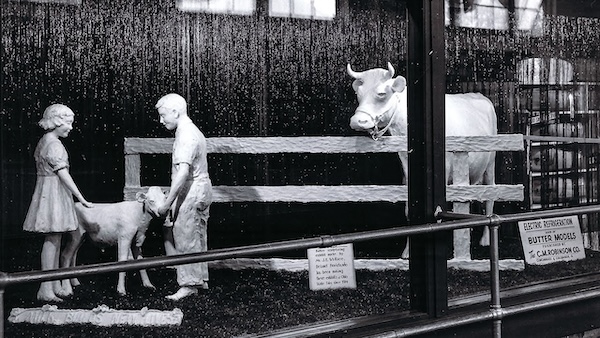As America prepares to celebrate 250 years, the Smithsonian Institution is drawing on its rich resources to showcase the people, places, and events that have contributed to our nation’s remarkable success. That includes US agriculture’s prominent role, which will be highlighted through various exhibits. Among those is the “State Fairs” exhibit, the centerpiece of which will be a beloved Midwestern icon – the Iowa State Fair’s Butter Cow! Below is a little background on the Butter Cow and The Smithsonian’s new State Fairs exhibit.
Iowa’s Butter Cow: The Butter Cow has been an Iowa State Fair staple since 1911, when J.K. Daniels created the first cow. The Butter Cow starts with a wood, metal, wire, and steel mesh frame and about 600 lbs. of low-moisture, pure cream Iowa butter. Once inside the 40-degree cooler, layers of butter are applied until a life-size butter cow emerges – measuring about 5-1/2-ft high and 8-ft long. Each year, much of the butter is recycled and can be reused for up to 10 years. Over the Fair’s 114-year history, there have been just five sculptors. Daniels was succeeded by J.E. Wallace, a sculptor and taxidermist, who sculpted the State Fair’s butter cows for 36 years until his death in 1956. Earl Frank Dutt was the butter cow’s official sculptor from 1957–1959. Then in 1960, Norma “Duffy” Lyon petitioned fair officials to become the sculptor, leading to the longest tenure of the Fair’s official butter sculptors at 45 years! Lyon also received approval in 1994 to create the first “companion” sculpture for the annual exhibit, a tradition that continues today. Lyon was succeeded in 2006 by Sarah Pratt, her apprentice of 15 years. Pratt sculpts her creations alongside twin daughters Hannah and Grace, who became apprentices under their mother in 2017. The trio also makes sculptures for the Kansas State Fair.
History of Butter Sculpting: While sculpting butter is not uniquely American, food historians widely agree that the US dairy industry raised the bar for the artform. Butter carving was an ancient craft in Tibet, Babylon, Roman Britain and elsewhere. The earliest known reference to a butter sculpture comes from the Renaissance and Baroque periods. During this time in Europe, “banquet art” was all the rage and cooks formed all sorts of foods into different shapes, including lots of butter. Butter sculpting continued into the 18th century when English dairy maids molded butter pats into decorative shape. The women would press their butter in round or brick-shaped custom wooden molds carved with details like cows, birds, flowers, and other designs. These molds and designs served as early family trademarks or dairy brands.
Caroline Shawk Brooks: In 1876, an American farm woman, Caroline Shawk Brooks, raised the bar considerably. She created her first butter sculpture that year after the failure of the farm’s cotton crop left the family in search of alternative income. Rather than molding the farm’s butter, Brooks sculpted the butter free-hand into shapes such as shells, animals, and faces. Brooks’ skills hit the national stage in 1874 her butter sculpture “Dreaming Iolanthe” drew national acclaim at a Cincinnati gallery. The New York Times declared that “no other American sculptress has made a face of such angelic gentleness as that of Iolanthe.” She created another version of the sculpture for the Centennial Exposition – the 1876 world’s fair held in Philadelphia, Pennsylvania – attracting huge crowds and gaining her international recognition. In 1878, she created a life-size version of “Dreaming Iolanthe” and shipped it to be exhibited at the Exposition Universelle in Paris. She recalled later being amused that customs officials listed her sculpture not as a work of art, but as “110 lbs. of butter.”
State Fairs: Brooks’ creations sparked the creativity of other rural artisans and by the 1890s, butter sculpting was no longer a novelty in the US. The heyday of the artform is considered to be about 1890 to 1930, a period that also coincided with the introduction and adoption of refrigeration. The first known butter cow sculpture appeared at the Ohio State Fair in 1903, entered by A. T. Shelton & Company, distributors of Sunbury Co-Operative Creamery butter. The sculpture was entered as part of a butter sculpting contest sponsored by Ohio State University and the Dairy Processors of Ohio. The contest did not have any restrictions on subject matter but the butter cow proved to be so popular that it later became a permanent attraction. The Ohio State Fair continues the tradition to this day.
The Smithsonian Exhibit, “State Fairs: Growing American Craft” will occupy both floors of the Renwick Gallery, the Smithsonian American Art Museum’s branch location for contemporary craft, from Aug. 22 to Sept. 7, 2026. It is the first exhibition dedicated to artists’ contributions to the great U.S. tradition of state fairs. Among the 240 artworks will be an octagon case in the center of the gallery, displaying the iconic butter cow. The exhibition is the culmination of five years of on-the-ground research involving visits to 15 state fairs across the U.S. Part of that tour took Smithsonian curator Mary Savig to Iowa, where she discovered the Pratts. Savig loved their story and asked them to contribute a life-size replica of this year’s Iowa State Fair sculpture. The Pratts crafted the sculpture before the exhibition’s opening, but they will be on call if touch-ups are required throughout the year. You can read about some of the unexpected challenges the Pratt women overcame to create the display HERE. Details about the Smithsonian’s State Fair exhibit can be found HERE.












